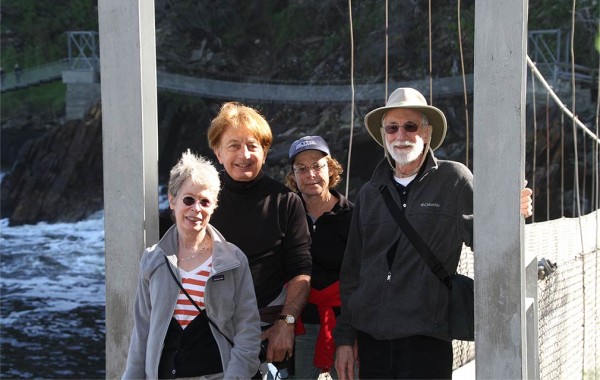
Carl Blackman ’63 (far right) with his wife, Carolyn Miller, were accompanied by Donald ’63 and Sheila Bergmann to South Africa when Blackman accepted the d’Arsonval Award. In the 55 years since the two men pledged the Tau Kappa Epsilon fraternity at Colgate, the four have traveled all over the world together.
Carl Blackman ’63
Biophysicist Carl Blackman ’63 is cooking up new ways to treat cancer, all thanks to a surprising discovery in the 1970s that questioned how microwave ovens work. He’s found that by changing particular properties of waves of energy — termed electromagnetic radiation — one can alter specific biological processes, and recently others have shown that altering these wave properties can help to slow the growth of cancer cells.
Armed with a PhD in radiation biophysics from Penn State, Blackman (who majored in physics at Colgate) has spent 44 years at the U.S. Environmental Protection Agency (EPA) studying electromagnetic radiation.
Electromagnetic radiation is all around us, including in the form of radio waves, Wi-Fi, power line fields, and lights. Blackman was specifically focused on the biological effects of radio waves, which are used at a particular frequency in microwave ovens, but also at lower concentrations in radio transmissions. “At the time, everyone accepted that the microwave oven worked using heat,” he said. “The higher the intensity (energy) of the radio waves, the faster things would heat up. But no one expected that radio waves could affect biological systems in some other manner.”
Then one day at a conference, Blackman heard about a strange new finding that challenged this assumption. When UCLA researchers beamed a low-intensity radio wave, one that was far too low in energy to generate heat, at chicken brain tissue in a test tube, they found that different amounts of calcium ions, which are important for neuronal communication, were released from the tissue. The amounts released depended on the frequency of the amplitude modulation (AM) of the radio waves. If the AM frequencies were too low, no calcium would be released. At a higher frequency, similar to that of brain waves, calcium release occurred, but when the frequency increased even more, the effect disappeared again. “It was bizarre,” he said. “We realized that — whoa! — this has nothing to do with heating.”
The first step to understanding was for Blackman to replicate the UCLA findings in his own lab, a feat that took nine months. Through subsequent experiments, Blackman found that there wasn’t just one radio wave frequency that caused the calcium ion release — there were many. In addition, much like the AM frequency “windows” that produced the biological effect, Blackman realized that adjusting the intensity of the radio waves could also change calcium ion release. “What we found was a pattern between the intensity windows as well as one between the frequency windows, which to this day has not been fully explained,” he said.
The general concept behind Blackman’s work — that specific properties of electromagnetic waves can affect biological processes — is currently being used to develop better treatments for cancer. It turns out that directing radio waves with a particular set of AM frequencies at liver and breast cancer cells can slow or halt their growth, although the specific AM frequencies that are effective against liver cells are different than those for breast cancer.
In recognition of his significant research contributions, Blackman was honored with the d’Arsonval Award. This is the highest honor bestowed by the Bioelectromagnetic Society, which he helped to found in 1978 and for which he served as president in 1990. He traveled to Cape Town, South Africa, less than two months after retiring from the EPA in April 2014, to receive the award.
A few months later, Blackman became an adjunct professor in the Department of Cancer Biology at Wake Forest University Medical School, where he now guides students who are studying how AM-modulated electromagnetic radiation can be used to enhance standard cancer treatments.
— Allison Curley Marin ’04






